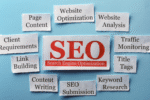AEO vs SEO: How to Optimize for Chatbots and Generative AI
Introduction:
SEO is about optimizing your website to rank higher in search engine results pages (SERPs) and drive organic traffic, whereas AEO (Answer Engine Optimization) focuses on structuring content to be featured directly in AI-powered search engines and voice assistants—often delivering answers without users needing to click through to a website.
The way people search online is evolving—and so must the way we optimize. It’s no longer just about Google ranking as we enter the age of chatbots and AI-driven search. Being the solution is the goal. Enter: AEO vs SEO.
What’s Going On? Why This Comparison Matters
Traditional Search Engine Optimization (SEO) has been around for decades. But now, with generative AI and answer engines like ChatGPT, Bing Copilot, and Google’s Search Generative Experience (SGE), a new paradigm is emerging—Answer Engine Optimization (AEO).
So if you’re wondering:
- How to future-proof your google trends content strategy,
- What AEO vs SEO really means, and
- How to optimize for chatbots and AI search
Let’s dive into it, point by point.
AEO vs SEO: The Core Difference
1. What is SEO (Search Engine Optimization)?
- SEO full form: Search Engine Optimization
- Traditional SEO is all about improving your visibility in search engine results (mainly Google).
- Focus areas include:
- Keyword targeting
- Backlink building
- Technical optimization
- Mobile performance
- User engagement signals (like time in view)
- SEO helps your content rank. It gets users to your site via search queries.
2. What is AEO (Answer Engine Optimization)?
- AEO full form: Answer Engine Optimization
- AEO focuses on how your content is interpreted and used by AI-powered engines like ChatGPT, Bing AI, Perplexity, and Google SGE.
- It’s less about clicks and more about being the direct answer to a user’s question.
- AEO is about structuring content in a way that makes it easy for machines to find, understand, and summarize.
Why Is AEO Becoming So Important Now?
1. Search is shifting from links to answers
- Tools like ChatGPT and Gemini now serve summarized answers, often without clicking a single link.
- That means the top spot on Google isn’t always the top spot in AI.
- AEO ensures your brand appears in these direct answers.
2. Generative AI is now a search front-end
- People are asking AI tools instead of just searching.
- Example: Instead of Googling “best coffee machines under $200”, users might ask a chatbot the same thing—and trust its summary.
3. AI relies on structured, high-quality content
- AI needs content it can parse easily.
- This includes:
- FAQ formats
- Clear entities and schemas
- Semantic consistency
- If your content isn’t “machine-readable,” you’re out of the AI loop.
Can SEO and AEO Work Together?
Absolutely—and they should!
- SEO gets users to your site. AEO gets your answers into AI summaries.
- Together, they:
- Improve discoverability
- Build brand authority
- Future-proof your content strategy
- Think of SEO as helping with “clicks” and AEO helping with “presence in AI.”
Pro Tip: Align your SEO and AEO by focusing on topic authority and structured knowledge. This is especially important when applying SEO strategies for e-commerce websites, where both visibility and quick, direct answers can influence purchase decisions.
How to Optimize Content for AEO (Answer Engine Optimization)
Let’s get into the how-to section.
1. Use structured data and schema markup
- Schema.org helps AI and chatbots understand your content.
- Add schema for:
- FAQs
- How-tos
- Products
- Reviews
- Tools like Merkle’s Schema Generator and Google’s Rich Results Test help validate this.
2. Adopt a Q&A format
- Use H2/H3 to ask common questions and give clear, direct answers.
- Ideal for voice search, chatbots, and zero-click searches.
3. Build topical authority
- Instead of focusing on one-off keywords, build clusters of related content.
- Example: If you’re in real estate, cover mortgage basics, loan calculators, credit scores, and down payment strategies as a topic cluster. This approach not only boosts your site’s relevance but also highlights the significance of keywords in digital marketing by connecting related terms within a broader context.
4. Improve entity clarity
- AI doesn’t understand ambiguity.
- Define your entities clearly: who, what, where, when, why.
- Use tools like InLinks or Kalicube to build and clarify your brand’s entity.
5. Optimize for “time in view” and dwell time
- While this is more of an SEO metric, longer engagement signals quality.
- Use internal links, multimedia, and clear CTAs to keep users engaged.
Internal Resource: Looking to boost both AEO and SEO? Check out the best SEO agency in Coimbatore for expert support.
AEO Metrics: How Do You Measure It?
1. Unlike SEO, AEO is harder to track directly.
But you can still gauge it through:
- Presence in AI summaries (manual testing in ChatGPT, Perplexity, etc.)
- Google SGE appearance (if available in your region)
- Voice search results (via smart devices)
- Featured snippets and People Also Ask (as transitional indicators)
Additionally, you can use Google Search Console to monitor your website for changes in impressions and clicks on pages optimized for concise, structured answers helping you spot indirect AEO impact.
2. Tools that help with AEO
Here are some tools to streamline your AEO workflow:
- AlsoAsked: To uncover real user questions
- Frase: For optimizing AI-friendly content formats
- InLinks: For internal linking and entity optimization
- Google’s NLP API: To see how your content is interpreted by machines
The Future of SEO: What’s Next?
1. AI-first search isn’t coming. It’s here.
- Google SGE is rolling out.
- OpenAI and Microsoft are building native AI browsers.
- Zero-click results are increasing.
2. SEO alone won’t cut it.
- Generative AI SEO strategies will become the norm.
- You must produce content that is cited by AI engines and ranked by search engines.
Final Thoughts: AEO vs SEO—Don’t Choose, Combine
The bottom line? Don’t treat AEO vs SEO as a rivalry. It’s a tag team.
- Use SEO to rank on Google.
- Use AEO to show up in AI-generated answers.
As AI reshapes how people find information, blending both strategies will give you a serious competitive edge. Start building not just for clicks, but for conversations.
FAQs
1. What is the major difference between SEO and AEO?
SEO focuses on ranking in search engines through keywords and backlinks. AEO is about structuring content so that AI tools can find and directly use it as an answer.
2. Why is AEO becoming more important now?
Because users are turning to AI chatbots and tools for quick, summarized information—bypassing traditional search results.
3. Can SEO and AEO be done together?
Yes, and they should be. SEO gets users to your site; AEO gets your answers into AI responses and voice assistants.
4. How do I optimize my content for AEO?
Use structured data, adopt a Q&A format, focus on entity clarity, and create comprehensive topic clusters that AI can easily parse.
5. Are there specific tools to help with AEO optimization?
Yes: Frase, InLinks, AlsoAsked, Kalicube, and Google’s NLP API are excellent for enhancing content for answer engines.











